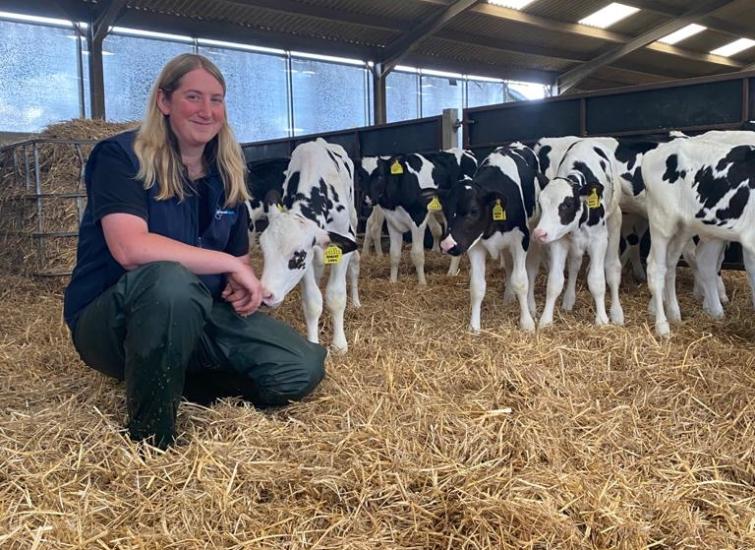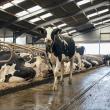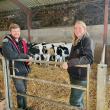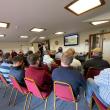Managing calf environments to improve animal health and profitability
First published in Dairy Farmer, Liz Newman discusses the benefits of manipulating the calves’ environment through microclimates to improve daily live weight gain (DLWG)

Liz Newman is our Heifer Rearing Specialist, working with clients throughout the UK to target calving at 24 months. Her objective on the farms she works with, is to continually improve calf health and productivity and a key part of this is the calves’ environment. Liz believes the environment can impact on all areas of calf rearing. “If you don’t have a well-prepared calf environment, then the effectiveness of any work done to manage colostrum, reduce antibiotic usage and improve nutrition, for example, will quite simply be reduced.”
Liz has recently implemented some practical trials on farm creating microclimates to prove the cost benefits of making environmental changes for the calf and with the aim of:
- Improving animal health by reducing infections such as pneumonia and scour
- Improving DLWG
Liz comments, “A calf microclimate looks to create the correct ambient temperature and relative humidity for calves between 0 to 8 weeks. The key is to keep the calves’ housing draught free but at the same time to provide good ventilation. There will always be pathogens on a farm, however, the difference between a calf suffering disease and being able to overcome it, is the balance between the number of challenging pathogens and the calves ability to fight those. Having an area that is well ventilated means that the number of air-borne pathogens are reduced.”
“For a calf to be in the best position to fight disease it must have a good immune function, including good passive transfer from the mother as well as good active immunity. They also require enough energy for maintenance, growth and disease response.”
Calves have a thermal comfort zone, which is their ideal temperature, beyond this they don’t like extremes of hot or cold. A temperature above 25°C and they are using energy to keep cool in the summer. In the winter months, the lower critical temperature (at which they need extra energy to keep warm), is 10-15°C and depends on airspeed, for calves under 3 weeks. For those over 3 weeks, it’s 5-10°C and highly dependent on airspeed.
Liz explains, “Any draughts within an area of where a calf is housed can cause a reduction in temperature, diverting energy away from growth as the calf tries to keep warm.”
ME maintenance is the amount of energy a calf needs to maintain the current body weight and is calculated as:-
4.2 x (0.1 x liveweight 0.75) at 15°C to 20°C
The total ME for maintenance and growth is calculated as:-
{0.1 x liveweight 0.75 + [(0.84 x liveweight 0.344) x (DLWG 1.2)]} x 4.2 at 15°C to 20°C.
Therefore, for a calf born at 40kg gaining 0.9kg/day the approximate energy requirements are shown below.
|
Energy Requirement (MJ/day) |
|||||
|
Age (week) |
At 15°c |
At 10°c |
At 5°c |
At 0°c |
At -5°c |
|
1 |
19 |
20 |
21 |
22 |
23 |
|
2 |
20 |
21 |
22 |
23 |
24 |
|
3 |
21 |
22 |
23 |
24 |
26 |
|
4 |
22 |
22 |
23 |
25 |
26 |
|
5 |
23 |
23 |
24 |
25 |
27 |
|
6 |
24 |
24 |
25 |
27 |
28 |
|
7 |
25 |
25 |
26 |
27 |
29 |
|
8 |
26 |
26 |
27 |
28 |
30 |
|
9 |
27 |
27 |
28 |
29 |
31 |
|
10 |
28 |
28 |
29 |
30 |
31 |
Wind chill factor (or draughts) affect temperature. A draught of 0.3meters per second will lower temperature by approx. 2°c.
|
Air speed at calf level |
|
|
0.15m/s |
Stale air – increases bacteria survival and pneumonia |
|
0.2m/s |
Draught-free |
|
0.3m/s |
Draught on calf – calf will become chilled |
|
Ref: AHDB, m/s = metres per second |
|
A 2°C drop would require the equivalent of approx. 20grams of milk powder per day to fill the energy required to warm the calf back up. On average, microclimates installed by customers have seen an increase in air temp of 2.5°C, plus the benefit of a draught free area. We also regularly see an increase in DLWG on our farms of 0.04-0.08kg/day.
Taking the example of 2-5°C temperature increase felt by calf, that would be a saving of 20-50 grams of calf milk replacer (CMR) per day. You would also see a reduction in cases of pneumonia, typically costing £44 per case plus £30 per calf in contact group. The creation of a microclimate and manipulation of the correct ambient temperature also impacts on growth targets and maintaining the health status of the calf, meaning they are more likely to achieve an age of first calving of 24 months. AHDB figures state that rearing costs of calving past 24 months are increased by £2.87 per day – that’s an extra £344 per heifer calving at 28 months!
What makes a good microclimate?
- Tall enough for calves to stand under
- Remember that calves need plenty of straw for “nesting” so you need to think how deep the bedding will be.
- Low enough to hold heat
- Adequate lying space
- Easy to move to clean out
- Mesh to allow airflow
- Straw to insulate
- can be different thicknesses dependant on temp
- will reduce risk of condensation
Liz continues, “It’s important to continually measure the temperatures inside your sheds and microclimates. In the summer, adjustments to your microclimate can be made through the amount of straw insulation on the top. You may need to lift them out altogether but actually, they can still be useful in providing shade if sheds are very sunny. Microclimates are an important part of manipulating the calves’ environment which is all part of a holistic view to calf rearing. Monitoring and evaluation should take place at all stages of youngstock development.”
〈 BACK














